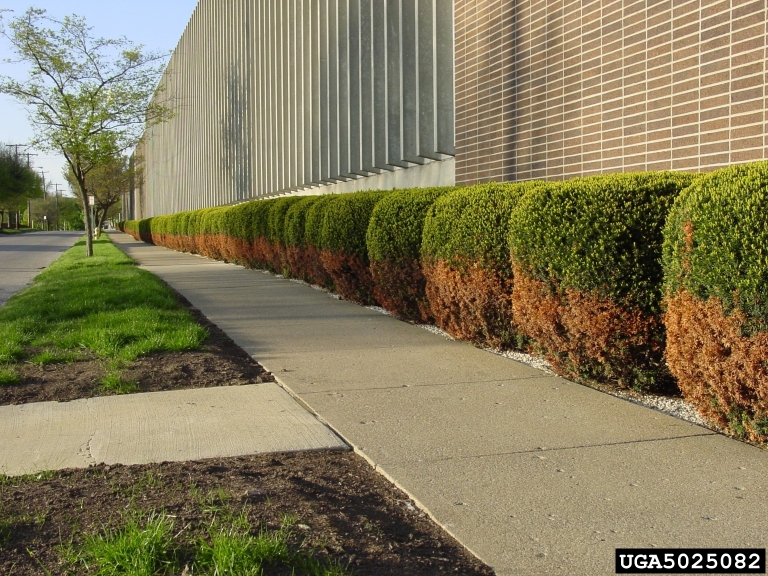
Salinity: Salt damage to soil and plants
cosmetic to damaging
Salinity is when salt dissolved in water is present in
Dissolved salts hold water in
Causes
- Excess or accumulated fertilizers, animal manure and compost.
- In cold regions like the Prairies, salt or chlorides are used to de-ice sidewalks and roads in winter. Melted ice and snow containing salts may run off to other areas of the home garden.
- Spray or splash may deposit road salts onto lawns, plant leaves, or needles.
Symptoms
Symptoms can take a long time to appear. Consider at least two years of history in your garden. Symptoms vary according to how much salinity is in the soil and because some plants are more tolerant of salinity than others. Here is what to look for:
- Drought-like symptoms: wilting, tissue death.
- Symptoms may be more severe on the side of the plant next to a road or sidewalk where de-icing products have been applied.
- Leaf margins are brown or scorched – damage slowly causes the entire leaf to die.
- Tip browning on evergreen needles or scales.
Snow covered branches may be protectedand less affected. - Leafy plants may be slow to bud and leaf out in spring. Flower buds may fail.
- Plants are stunted and slow to grow.
- Brown patches on lawns where snow treated with de-icing products
has been piled. Dessicated leaves, stems or branches from salt-spray contact.
Prevention: Winter damage
- Avoid standing water or unmanaged snow in walking areas in the
winter time . Shovel regularly, especially if we experience a light melting. - Shovel your clean snow onto your garden beds whenever possible as this will help them overwinter and provide some extra water in the spring. Avoid piling ice or snow treated with de-icing products on your lawn, garden, or the root zone of trees.
- Use ice melt products according to instructions. Do not apply more than is recommended and use only where it is needed.
- Some de-icers only melt ice at certain temperatures – check the temperature outside and use the product when it is most effective.
- Avoid planting in areas where melted snow naturally accumulates in spring.
- Broken eggshells, clay kitty litter, sand, or sawdust provide traction (but do not melt ice). Clay kitty litter can become problematic in soils. Sand or sawdust
are generally harmless in smallerquantities, but can be problematic in large quantities. Eggshells are generally harmless but are inconvenient.
Prevention:
- Use fertilizers according to the needs of your plants and follow directions on the package. More is not better when it comes to fertilizer.
- Compost and animal manures are great sources of organic matter. Salts may accumulate if too much is applied. Apply no more than 2.5 - 5 cm (1” - 2”)every year.
What to do about salinity
- Apply water to soil liberally and slowly to leach salts out of the root zone. Eight centimeters (about 3”) of water removes about half the salinity in soil; 12 cm (about 5”) of water removes about 90 percent.
- Salt-spray on plant branches, leaves, or needles may appear white. Wash thoroughly to remove the salt. Follow-up with watering the soil.
- Mulch your soil to conserve moisture. Salts are more damaging when soil is dry.
- Protect plants with tarps or covers if there is no other option for piling snow contaminated with de-icing salts.
- Plant salt-tolerant plants near sidewalks and roads where salts are regularly used.
Sources
https://open.alberta.ca/dataset/2818626#summary
https://www.extension.purdue.edu/extmedia/id/id-412-w.pdf (Salt damage in landscape plants)

